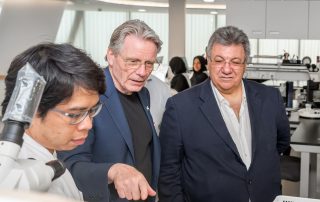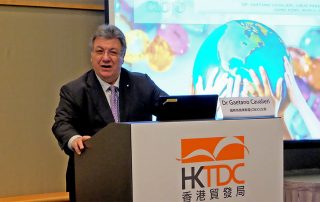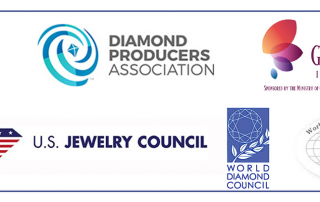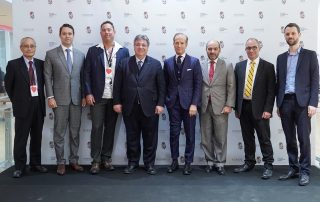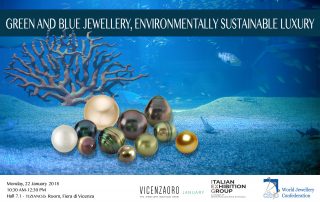CIBJO President visits Bahrain as guest of DANAT, Arabian Gulf country’s official pearl and gemstone institute
Kenneth Scarratt (centre), CEO of DANAT and President of the CIBJO Pearl Commission, giving CIBJO President Gaetano Cavalieri a tour of the Bahrain Institute for Pearls & Gemstones’ new gem and pearl testing facility in Manama.
April 10, 2018
CIBJO President Gaetano Cavalieri has concluded a week-long visit to the Kingdom of Bahrain, as the guest of DANAT, the Bahrain Institute for Pearls & Gemstones, during which he met with the leadership of the country’s fast-developing gemstone and jewellery centre, and discussed the possibility of its hosting the CIBJO Congress in 2019.
Located on an archipelago on the northern flank of the Arabian Peninsula, the energy-rich Kingdom of Bahrain is home to a pearling industry that traces its history back 4,000 years. DANAT, the Bahrain Institute for Pearls and Gemstones, was formerly was established in 2017, as a wholly-owned subsidiary of the Bahrain Mumtalakat Holding Company, the Kingdom’s sovereign wealth fund. Upgrading a 27-year pearl and gem-testing laboratory that, when it was formed in 1990, was the first such facility in the Middle East, under its new structure and with a state of the art laboratory it aims to become an internationally-recognised institute for third party verification services and scientific research into pearls and gemstones.
Although it just recently announced the discovery of massive shale oil reserves off its western coast, Bahrain was the first of the Gulf states to make the transition from a predominantly energy-based economy into a one that is today anchored by banking, trade and tourism. Mumtalakat was created by a royal decree in 2006, with the objective of pursuing long-term value-enhancing opportunities for the country’s state-owned, non-oil and gas-related assets. It established DANAT from the older Pearl & Gem Testing Laboratory to support the country’s distinguished pearling history and heritage, as well as to tap into the rapid growth of the jewellery industry across the world, though the issuance of verification and authentication reports, continuous scientific research and analysis of pearls and gemstones, and the provision of ongoing training programmes in the field of gemmology.
To manage the process, DANAT appointed Kenneth Scarratt, a world renowned gemmologist as its CEO. Mr. Scarratt also serves as President of CIBJO’s Pearl Commission.
“One of our guiding principles in CIBJO is our conviction that the jewellery and gemstone business, if responsibly and professionally managed, has the capacity to generate economic opportunity, growing existing markets and creating new ones where they never existed,” said Dr. Cavalieri. “For that to happen, however, the proper infrastructure and a wealth of knowledge is required. This is what we are seeing in Bahrain. Its impact on the markets in the Gulf region, the Middle East and far beyond is likely to be tremendous.”
During his meetings in Bahrain, DANAT Chairman Yaser Alsharifi and Mr. Scarratt proposed that Bahrain’s capital of Manama host the CIBJO Congress in 2019. “We were honoured to receive the invitation, which will be brought for discussion before the CIBJO Board of Directors,” Dr. Cavalieri said. “It is an event that brings together the leadership of the international jewellery and gemstone industry from around the world, and it certainly be an excellent showcase for what is being built and achieved today in Bahrain.”

